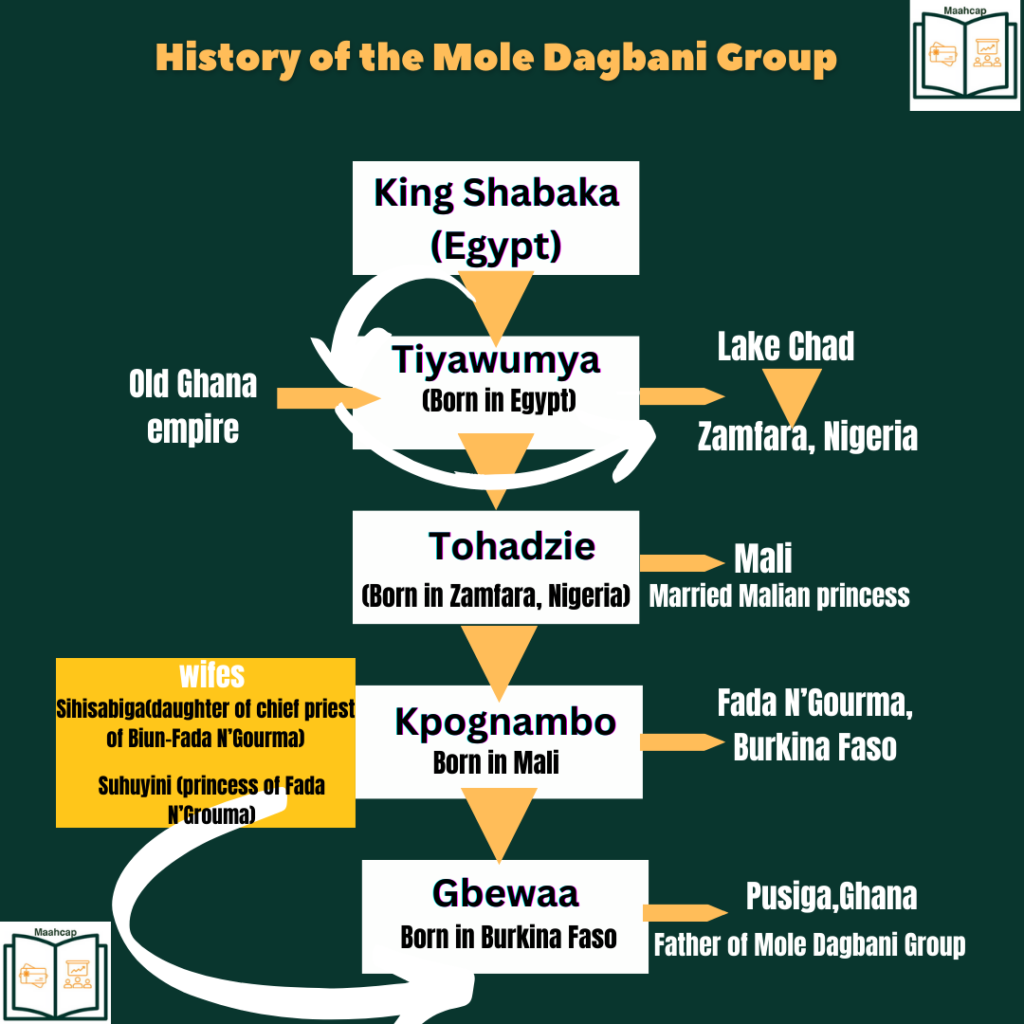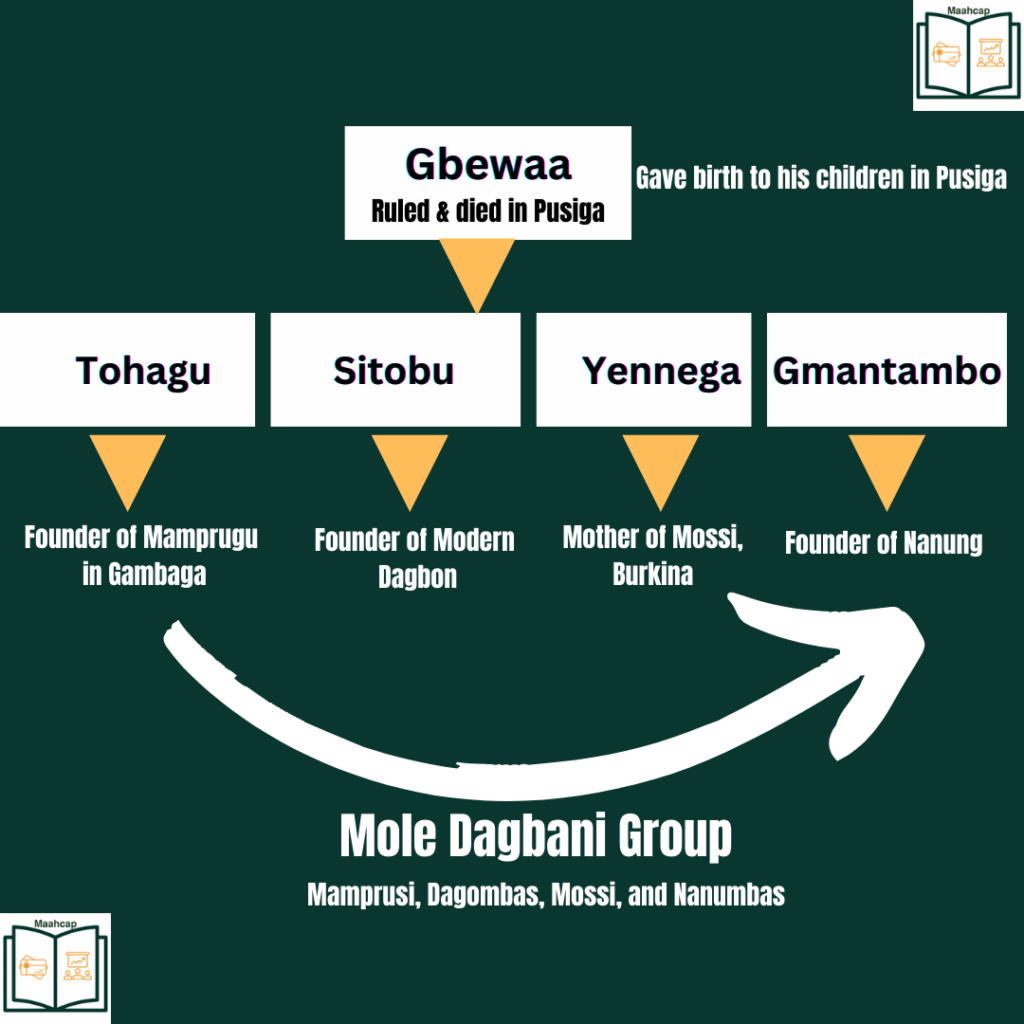History of the Mole-Dagbani Group of Ghana
The Mole-Dagbani ethnic group is a notable descendant of the old Ghana empire, Tohadzie (The Red Hunter), and Naa Gbewaa. They inhabit present-day Northern Ghana and form about 17 percent of Ghana’s population. They speak Dagbani, Mossi, Mampruli, and Nanugli, a subgroup of the Gur languages.
Origin and Expedition of Tohadzie
Tohadzie, whose name roughly translates to “The Red Hunter,” was the son of Tiyawumya. Tiyawumya was born in Massari around the 11th to the 12th century into the Royal House of ancient Egypt. He is a descendant of King Shabaka, one of the Black Pharaohs who ruled ancient Egypt and from the Kush Kingdom. Tiyawumya later settled in the old Ghana empire (Wagadou), which was wealthy due to its role in the Trans -Saharan trade. After the breakup of the Ghana empire(present-day southeastern Mauritania and part of Mali) in the 13th century, he migrated to Lake Chad. Eventually, he settled in Zamfara State, Nigeria, where he fathered Tohadzie. Tohadzie later earned a reputation as a courageous and skilled hunter1.
In one of his hunting expeditions, Tohadzie found himself in a small town in Mali, where he bravely killed a wild bush cow that had been terrorizing the villagers and taking their only water source(river). In gratitude, the town’s chief gave his daughter Princess Pagawubiga to Tohadzie for marriage. Tohadzie and Pagawubiga had a son named Kpognambo2.
Journey of Kpognambo to Fada N’Gourma (Fadan Grumah), Burkina Faso
Kpognambo learned his father’s hunting trade and eventually journeyed to Biun in Fada N’Gourma (Fandan Grumah), a city in Burkina Faso. In Fada N’Gourma, Kpognambo married Sihisabiga, the daughter of the Biun’s fetish priest, and they had three sons, including Malgimsim, Nyelgili, and Namzisheli. Kpognambo later married Fada N’Gourma’s chief daughter, Princess Suhuyini, who gave birth to Gbewaa (Nadega). Kpognambo established the chieftaincy of Biun and ruled it till his death. After his death, his sons were at war over the chieftaincy of Biun. Three of his sons left for the present-day Upper East Region of Ghana. Nyeligili founded the chieftainship of Nangodi in the Nabdam district, and Namzisheli founded the chieftainship of Tongo in the Talensi district. Gbewaa and his mass followers left Biun for Pusiga to establish the Greater Dagbon Kingdom1.

The Reign of Naa Gbewaa (Nadega)
In Pusiga, Naa Gbewaa established a chieftaincy system known as NAM, which was exclusively for his male descendants. The lion and leopard skins became symbols of the Gbewaa tradition, with Naa Gbewaa sitting on them.
Naa Gbewaa had several wives and many children, including Kachagu, Zirili, Tohagu, Sitobu, ŋmantambo, Kufogu, Yennenga, and others. Kachagu and Kufogu shared the same mother, while Zirili and Tohagu had the same mother. Sitobu and Gmantambo were of one mother. In contention for the throne, Zirili (the eldest son) set a trap which killed Kufogu, leading to Naa Gbewaa’s demise afterwards in the 13th century. Naa Gbewaa’s grave is in Pusiga, Upper East Region and is now a famous shrine called Gbewaa Shrine1.
Amid the turmoil, Kufogu’s sister, Kachagu, demanded to be Naa Gbewaa’s successor since she was older than Zirili. This was agreed upon, and Kachagu was enthroned. Therefore, Kachagu was the first and only female to take over the chieftaincy (NAM) of the Greater Dagbon Kingdom/Mole-Dagbon. However, Zirili orchestrated a fake war, causing Kachagu to flee and hide in the hollow of a kapok tree. Zirili then named her the Queen of the kapok tree (Gundo-Naa), a title still held by female children of the Yaa-Naa. Zirili then became the chief, succeeding Gbewaa2.
The Origin of the Mole-Dagbani Group
Therefore, due to the struggle over the NAM or chieftaincy after the death of Gbewaa, Some of his children, including Sitobu, Tohagu, and Gmantambo, moved southwards from Pusiga. In the 14th century, Tohagu, Zirili’s brother from the same mother, sought to claim the Gbewaa chieftaincy but faced opposition from Sitobu and Gmantambo. Who argued that it was time for someone from a different mother to rule the Kingdom. Tohagu and his followers settled permanently in Gambaga and became Mamprusi people in the northeast region of Ghana. Meanwhile, Sitobu, Gmantambo, and their followers continued their journey1.
Sitobu ultimately settled in Nambrugu, within the Kariga district and founded the modern Dagbon Kingdom with strong support from his brother, Gmantambo. After Sitobu founded the Dagbon Kingdom, the kingship became known as Yaa Naa, which literally means king of strength (power). Sitobu’s success in the succession was further celebrated with the appellation “Sigri ni tobu, duri ni nam,” meaning “Descending with war and ascending as King2.”
Gmantambo, Sitobu’s brother, later founded Nanung, whose people are called Nanumbas, with Bimbila being their capital within the Northern Region.
Yennenga, a daughter of Naa Gbewaah, who was also a courageous female warrior, married a Grumah, and they established the Kingdom of the Mossi. Their union gave rise to the famous king of the Mossi ethnic group, Ouedraogo, forging a strong bond between the Mossi and the Dagombas.

Therefore, Mossi, Dagombas, Mamprusi, and Nanumbas are the grandchildren of Naa Gbewaa and, therefore, called the Mole-Dagbani group. They are one people.
Our heritage is our identity, and understanding our past is essential not to cling to it with bitterness but to appreciate its lessons. By learning to love ourselves and our heritage, we can extend that love to humanity and make the world better. It is important to remember that no tribe, race, or religion is inherently good or bad. The actions of a few individuals do not represent the entire group. A bad encounter with someone from a particular background should not lead to generalizations. Let us give each person a chance to prove their character, judging them as individuals rather than by the behaviour of others.
By: Huzeima Mahamadu (Researcher and Content Creator)
References
- Mahamadu, H. (2023). Journey Into Ghana: History, People, and Attractions (Vol. 1). Mahcap. ↩︎
Mohammed, Y., Alhassan, E., & Sayibu, M. S. (2022). Female Chiefs in Dagbon Traditional Area: Role and Challenges in the Northern Region of Ghana. International Journal of Sociology and Anthropology Research, 8(2), 57–81. https://doi.org/10.37745/ijsar.15/vol8n2pp5781
↩︎
